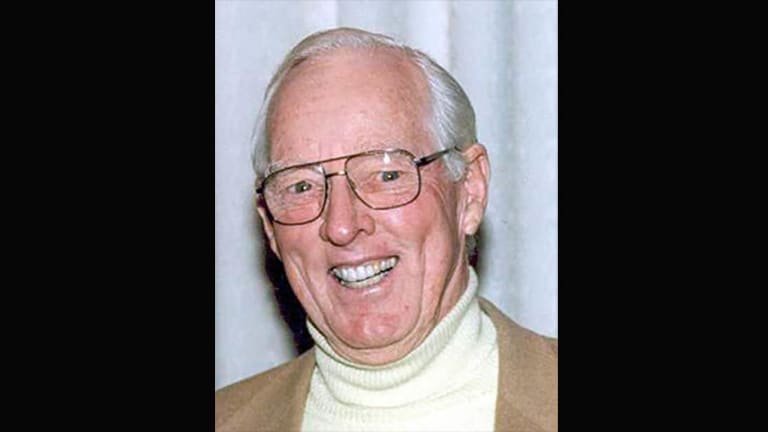
Longtime Golf Writer Kaye Kessler, Who Covered 56 Masters Tournaments, Dies at 97

Last week longtime golf writer Kaye Kessler died at age 97, 11 days before what would've been his 98th birthday. (Ed note: An earlier version of this story erroneously reported Kessler's age as 98.) Early in his career, Kessler covered Jack Nicklaus as a junior golfer and went on to befriend the Golden Bear. Kessler went on to cover 56 Masters Tournaments and chronicle countless prominent golf figures and legendary moments. Morning Read contributor Gary Van Sickle wrote a piece on Kessler during the 2017 Memorial Tournament for Morningread.com. We've republished that story here.
DUBLIN, Ohio—Jack Nicklaus isn’t playing golf this week but in a weird way, the Memorial Tournament becomes more about him with each passing year. He’ll hate that sentence, of course, because he wants the Memorial to be about the great golf played and the eventual champion, not about him.
Arnold Palmer has come and gone, though, and time’s stark reality makes us cherish our remaining national treasures more than ever. Nicklaus is one of those.
So is Kaye Kessler. His life’s course was irreparably altered in 1950 when Scioto Country Club hired a new golf professional, Jack Grout, and Kessler was sent over to write a story about him for his paper, the Columbus Citizen. The paper’s photographer needed a photo so Grout posed with a posse of Scioto junior golfers. One was a 10-year-old named Nicklaus.
Kessler enjoyed covering Ohio State football with his pal, Coach Woody Hayes, and Ohio State basketball with his best friend, Coach Fred Taylor. He had no idea the Nicklaus kid was about to turn him into his personal biographer through the process of winning 18 major championships. Jack’s exploits, plus Kessler’s writing and reporting skills, made Kessler one of the era’s most important golf writers.
Once Nicklaus beat Arnold Palmer to win the U.S. Open at Oakmont, the newspaper finally assigned Kessler to start going to the big tournaments to write about Grout’s best student. “I went to the Masters in 1963,” Kessler said, “and I haven’t missed one since.”
That’s 55 Masters if you’re keeping score. Kessler is 93 now, lives south of Denver and still gets around pretty well despite what he calls “bone-on-bone” knees. His newspaper went under in 1984, then he had a nice run as media relations director for the International Tournament at Colorado’s Castle Pines. Kessler is back for another Memorial Tournament this week—he’s been a fixture here since the event’s origin. “I say I’m semi-tired, not semi-retired,” he joked as we chatted in the Muirfield Village clubhouse.
If you watched “Jack,” Golf Channel’s terrific three-part series on the Nicklaus Era, you caught some of Kessler’s recollections. He is the guardian of all things Jack. “No one has walked more holes following Jack than me, other than Barbara,” Kessler said, referring to Jack’s wife.
Kessler typically wrote two stories every day at major championships—one on how the tournament was going and one on how Jack was doing. A lot of times, they turned into the same story by the end of the week.
“Back then, we only had eight columns for the sports section and I kept filling the whole space with stuff about Jack” Kessler recalled. “Some of the editors who didn’t know anything about golf would get upset.”
Golf wasn’t what Kessler expected to do with his life. He worked for the Citizen, then served as a staff sergeant in Army intelligence in London during World War II. He rubbed shoulders with baseball catcher and legendary spy Moe Berg (“He was always furtive, we never knew where the hell he was,” Kessler said) and Lise Meitner, an Austrian-Swedish physicist working in Germany in the late 1930s who helped split the atom but was left out of the 1944 Nobel Prize for chemistry in part because of politics—she was slow to leave Germany, and had to hide from the Nazis in Austria. (“We were supposed to get her out but she didn’t want to come,” Kessler said. “She had some jewelry she wanted to get out to her relatives in England, so we did that.”) President Harry Truman honored her in the U.S. in 1946 as the Woman of the Year.
Kessler went back to the newspaper after the war and married the Nebraska girl he’d met in London, which she agreed to do only if he finished his college degree at Ohio State University. He got his diploma from OSU. So did Nicklaus, who received an honorary degree in 1972 alongside another OSU notable, Olympic track hero Jesse Owens.
“Those were two legends,” Kessler said.
I watched him nod in approval and thought, Make it three, Mr. Kessler.